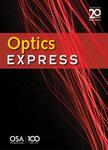版权所有:内蒙古大学图书馆 技术提供:维普资讯• 智图
内蒙古自治区呼和浩特市赛罕区大学西街235号 邮编: 010021

作者机构:Univ Calif San Diego Dept Elect & Comp Engn 9500 Gilman Dr La Jolla CA 92093 USA Univ Calif San Diego Mat Sci & Engn Program 9500 Gilman Dr La Jolla CA 92093 USA Univ Calif San Diego Ctr Memory & Recording Res 9500 Gilman Dr La Jolla CA 92093 USA
出 版 物:《OPTICS EXPRESS》 (Opt. Express)
年 卷 期:2023年第31卷第5期
页 面:8714-8724页
核心收录:
学科分类:070207[理学-光学] 07[理学] 08[工学] 0803[工学-光学工程] 0702[理学-物理学]
基 金:Gordon and Betty Moore Foundation National Science Foundation [DGE-2038238]
主 题:Far field diffraction Image metrics Neural networks Reconstruction algorithms Spatial frequency Structured illumination microscopy
摘 要:Structured illumination microscopy (SIM) is a popular super-resolution imaging technique that can achieve resolution improvements of 2x and greater depending on the illumination patterns used. Traditionally, images are reconstructed using the linear SIM reconstruction algorithm. However, this algorithm has hand-tuned parameters which can often lead to artifacts, and it cannot be used with more complex illumination patterns. Recently, deep neural networks have been used for SIM reconstruction, yet they require training sets that are difficult to capture experimentally. We demonstrate that we can combine a deep neural network with the forward model of the structured illumination process to reconstruct sub-diffraction images without training data. The resulting physics-informed neural network (PINN) can be optimized on a single set of diffraction-limited sub-images and thus does not require any training set. We show, with simulated and experimental data, that this PINN can be applied to a wide variety of SIM illumination methods by simply changing the known illumination patterns used in the loss function and can achieve resolution improvements that match theoretical expectations.